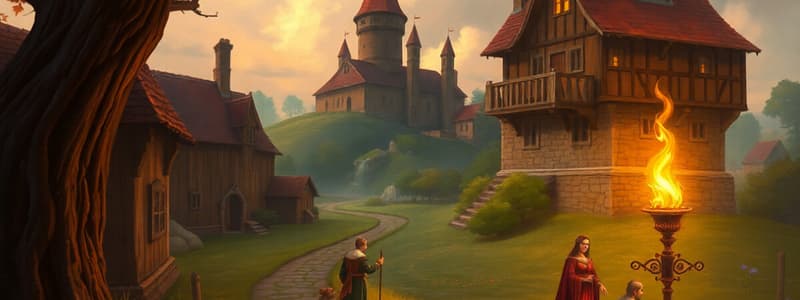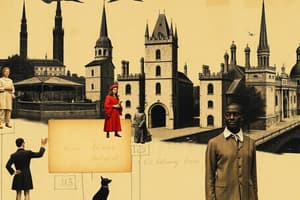Podcast
Questions and Answers
Which social class was MOST criticized in Chaucer's Canterbury Tales?
Which social class was MOST criticized in Chaucer's Canterbury Tales?
- Nobility and upper middle class
- Merchants
- Commoners
- Higher clergy (correct)
Chaucer's use of iambic pentameter and rhyming couplets primarily contributes to what aspect of The Canterbury Tales?
Chaucer's use of iambic pentameter and rhyming couplets primarily contributes to what aspect of The Canterbury Tales?
- Its allegorical depth and complex symbolism
- Its stark realism and unflinching portrayal of poverty
- Its rhythmic quality and structured verse form (correct)
- Its chaotic structure, mirroring the randomness of life
What is the primary function of the frame narrative in The Canterbury Tales?
What is the primary function of the frame narrative in The Canterbury Tales?
- To provide a detailed historical background of fourteenth-century England.
- To provide a structure for housing diverse stories and perspectives. (correct)
- To offer a straightforward, unbiased account of medieval society.
- To showcase Chaucer's knowledge of classical literature and mythology.
The inclusion of characters from various social classes in The Canterbury Tales MOSTLY allowed Chaucer to do what?
The inclusion of characters from various social classes in The Canterbury Tales MOSTLY allowed Chaucer to do what?
In The Canterbury Tales, what is the significance of the characters meeting in Southwark?
In The Canterbury Tales, what is the significance of the characters meeting in Southwark?
How did Chaucer's social background influence his writing of The Canterbury Tales?
How did Chaucer's social background influence his writing of The Canterbury Tales?
Which of the following best describes the literary genre of 'estates satire' as exemplified in The Canterbury Tales?
Which of the following best describes the literary genre of 'estates satire' as exemplified in The Canterbury Tales?
What can be inferred from Chaucer's relatively neutral or less critical portrayal of merchants and commoners in The Canterbury Tales?
What can be inferred from Chaucer's relatively neutral or less critical portrayal of merchants and commoners in The Canterbury Tales?
How might Chaucer's use of irony affect a reader's interpretation of the characters in The Canterbury Tales?
How might Chaucer's use of irony affect a reader's interpretation of the characters in The Canterbury Tales?
What led to social mobility during the Middle English period as reflected in Chaucer's life?
What led to social mobility during the Middle English period as reflected in Chaucer's life?
Which of the following best describes the verse form MOSTLY used in The Canterbury Tales?
Which of the following best describes the verse form MOSTLY used in The Canterbury Tales?
What is the significance of The Canterbury Tales being unfinished?
What is the significance of The Canterbury Tales being unfinished?
What is the role of the narrator in The Canterbury Tales?
What is the role of the narrator in The Canterbury Tales?
How does Chaucer's The Canterbury Tales reflect the social changes occurring during the Middle English period?
How does Chaucer's The Canterbury Tales reflect the social changes occurring during the Middle English period?
What is the significance of Chaucer's use of French loan words in The Canterbury Tales?
What is the significance of Chaucer's use of French loan words in The Canterbury Tales?
What is a 'fabliau' as exemplified in some of The Canterbury Tales?
What is a 'fabliau' as exemplified in some of The Canterbury Tales?
Who was Giovanni Boccaccio, and what is the connection between his work and The Canterbury Tales?
Who was Giovanni Boccaccio, and what is the connection between his work and The Canterbury Tales?
What is implied by the absence of characters from the 'top layer' (king, high nobility) and 'bottom layer' (beggars, the very ill) of society in the General Prologue of The Canterbury Tales?
What is implied by the absence of characters from the 'top layer' (king, high nobility) and 'bottom layer' (beggars, the very ill) of society in the General Prologue of The Canterbury Tales?
How does Chaucer utilize irony in his descriptions of the pilgrims in The Canterbury Tales?
How does Chaucer utilize irony in his descriptions of the pilgrims in The Canterbury Tales?
What distinguishes the Middle English period (14th-15th centuries) from earlier periods of English history?
What distinguishes the Middle English period (14th-15th centuries) from earlier periods of English history?
Flashcards
First Estate
First Estate
King, clergy as right hand, rules everything.
Second Estate
Second Estate
Nobles; exempt from taxes and military service.
Third Estate
Third Estate
90% of the population; subject to taxation and military service.
Estates Satire
Estates Satire
Signup and view all the flashcards
Fables
Fables
Signup and view all the flashcards
Fabliaux
Fabliaux
Signup and view all the flashcards
Frame Narrative
Frame Narrative
Signup and view all the flashcards
Iambic Pentameter
Iambic Pentameter
Signup and view all the flashcards
Rhyming Couplets
Rhyming Couplets
Signup and view all the flashcards
Intradiegetic Narrator
Intradiegetic Narrator
Signup and view all the flashcards
Study Notes
- The Middle English period took place during the 14th and 15th centuries.
History
- The three estates consisted of the King/clergy, nobles, and commoners.
- Social mobility increased, allowing people to change estates.
- The First Estate included the King, who ruled everything, and the clergy, who were the King's right hand.
- The Second Estate consisted of nobles who were exempt from taxes and military service.
- The Third Estate comprised 90% of the population, who were taxed and required to perform military service.
- Chaucer, the son of a wine merchant (Third Estate), served as an attendant at court and held administrative posts, exemplifying social mobility.
The Canterbury Tales – Chaucer (ca 1386-1400)
- Multiple manuscripts and early printed books exist, but none are from Chaucer's time.
- The tales are in different orders and remain unfinished.
- They contain many French loan words.
- The tales blend genres like romances, fables, fabliaux, and estates satire, exposing corruption across social classes.
- Not all tales share the same genre.
- Characters in the General Prologue exclude the highest (king, nobles) and lowest (ill, poor, beggars) extremes of society.
- Commoners, such as merchants and lower church orders, are most represented.
- All social classes and estates are represented.
- Chaucer drew inspiration from classical models such as Giovanni Boccaccio’s Decamerone, using the frame narrative.
Stylistic and Narrative Features
- Uses iambic pentameter, consisting of an unstressed followed by a stressed syllable, with five stresses per line.
- Employs rhyming couplets, a standard English verse form.
- Uses a frame narrative.
- Features a prominent, intradiegetic narrator who is a character in the story.
- Uses irony in praise and neutral descriptions potentially to convey criticism.
- The characters meet in Southwark, where the narrator speaks with everyone and provides personal impressions.
- The characters depart and tell their stories.
- The higher clergy is the most criticized class, including the Prioress and Friar, for their luxury and showiness.
- There is a more positive view of the lower church orders.
- The nobility and upper middle class (Bourgeoisie) such as the Knight and Wife of Bath receive the most text.
- Merchants are portrayed more neutrally, with minor faults compared to higher classes.
- Commoners are also criticized but receive shorter, more neutral descriptions.
- Merchants and commoners are criticized the least.
Studying That Suits You
Use AI to generate personalized quizzes and flashcards to suit your learning preferences.




